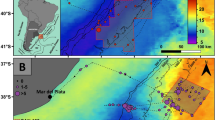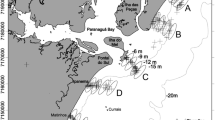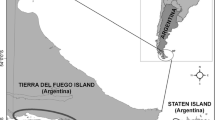Abstract
In the Mediterranean Sea, Aristaeomorpha foliacea and Aristeus antennatus are the most important target species of deep-sea trawl fisheries. Previous studies performed in several areas of the Mediterranean highlighted the key role played by both environmental factors, such as temperature, and anthropogenic activities, such as fishing, in affecting the abundance and distribution of the two species. The present study is aimed at investigating the effects of environmental and anthropogenic drivers on the abundance and spatial distribution of A. foliacea and A. antennatus in the Ligurian and northern and central Tyrrhenian Seas (NW Mediterranean). To this end, the time series of MEDITS trawl survey data (1994–2015) were analyzed together with environmental variables, namely sea surface temperature, current speed, and fishing effort by means of GAM. The results show that fishing plays an important role in shaping the spatial distribution of the two species. A. antennatus is prevalent where fishing effort is higher; this can be related to the higher resilience of blue and red shrimp to fishery impact. In contrast, high temperatures are associated to the prevalence of A. foliacea. Therefore, the abundance and spatial distribution of this species is mainly driven by temperature.








Similar content being viewed by others
References
Anderson, C. N. K., C. Hsieh, S. A. Sandin, R. Hewitt, A. Hollowed, J. Beddington, R. M. May & G. Sugihara, 2008. Why fishing magnifies fluctuations in fish abundance. Nature 452: 835–839.
Beggs, S. E., M. Cardinale, R. J. Gowen & V. Bartolino, 2013. Linking cod (Gadus morhua) and climate: investigating variability in Irish Sea cod recruitment. Fisheries Oceanography 23: 54–64.
Belcari, P., C. Viva, M. Mori & S. De Ranieri, 1997. Fishery and biology of Aristaeomorpha foliacea (Risso, 1827) (Crustacea: Decapoda) in the Northern Tyrrhenian Sea (western Mediterranean). Journal of the Northwestern Atlantic Fishery Science 31: 195–204.
Bertrand, J. A., L. Gil de Sola, C. Papaconstantinou, G. Relini & A. Souplet, 2002. The general specifications of the MEDITS surveys. Scientia Marina 66(Suppl. 2): 9–17.
Capezzuto, F., R. Carlucci, P. Maiorano, L. Sion, D. Battista, A. Giove, A. Indennidate, A. Tursi & G. D’Onghia, 2010. The bathyal benthopelagic fauna in the north-western Ionian Sea: structure, patterns and interactions. Chemistry and Ecology 26: 199–217.
Carbonell, A., M. Carbonell, M. Demestre, A. Grau & S. Monserrat, 1999. The red shrimp Aristeus antennatus (Risso, 1816) fishery and biology in the Balearic Islands, Western Mediterranean. Fisheries Research 44: 1–13.
Carlucci, R., G. D’Onghia, L. Sion, P. Maiorano & A. Tursi, 2006. Selectivity parameters and size at first maturity in deep-water shrimps, Aristaeomorpha foliacea (Risso, 1827) and Aristeus antennatus (Risso, 1816), from the North-Western Ionian Sea (Mediterranean Sea). Hydrobiologia 557: 145–154.
Cartes, J. E., F. Maynou & E. Fanelli, 2011. Nile damming as plausible cause of extinction and drop in abundance of deep-sea shrimp in the western Mediterranean over broad spatial scales. Progress in Oceanography 91: 286–294.
Cartes, J. E., E. Fanelli, K. Kapiris, Y. K. Bayhan, A. Ligas, C. López-Pérez, M. Murenu, V. Papiol, P. Rumolo & G. Scarcella, 2014. Spatial variability in the trophic ecology and biology of the deep-sea shrimp Aristaeomorpha foliacea in the Mediterranean Sea. Deep-Sea Research I 87: 1–13.
Chartosia, N., T. Tzomos, M. S. Kitsos, I. Karani, A. Tselepidesand & A. Koukouras, 2005. Diet comparison of the bathyal shrimps, Aristeus antennatus (Risso, 1816) and Aristaeomorpha foliacea (Risso, 1827) (Decapoda, Aristeidae) in the eastern Mediterranean. Crustaceana 78(3): 273–284.
Cau, A., A. Carbonell, M. C. Follesa, A. Mannini, L. Norrito, L. Orsi-Relini, C.-Y. Politou, S. Ragonese & P. Rinelli, 2002. MEDITS-based information on the deep-water red shrimps Aristaeomorpha foliacea and Aristeus antennatus (Crustacea: Decapoda: Aristeidae). Scientia Marina 66(Suppl. 2): 103–124.
Colloca, F., G. Mastrantonio, G. Jona Lasinio, A. Ligas & P. Sartor, 2014. Parapenaeus longirostris (Lucas, 1846) an early warning indicator species of global warming in the central Mediterranean Sea. Journal of Marine Systems 138: 29–39.
Company, J. B., P. Puig, F. Sardà, A. Palanques, M. Latasa & R. Scharek, 2008. Climate influence on deep sea populations. Plos ONE 3(1): e1431. https://doi.org/10.1371/journal.pone.000143.
Demestre, M. & P. Martín, 1993. Optimum exploitation of a demersal resource in the western Mediterranean: the fishery of the deep-water shrimp Aristeus antennatus (Risso, 1816). Scientia Marina 57(2–3): 175–182.
D’Onghia, G., F. Capezzuto, C. Y. Mytilineou, P. Maiorano, K. Kapiris, R. Carlucci, L. Sion & A. Tursi, 2005. Comparison of the population structure and dynamics of Aristeus antennatus (Risso, 1816) between exploited and unexploited areas in the Mediterranean Sea. Fisheries Research 76: 22–38.
D’Onghia, G., P. Maiorano, F. Capezzuto, R. Carlucci, D. Battista, A. Giove, L. Sion & A. Tursi, 2009. Further evidences of deep-sea recruitment of Aristeus antennatus (Crustacea: Decapoda) and its role in the population renewal on the exploited bottoms of the Mediterranean. Fisheries Research 95: 236–245.
D’Onghia, G., A. Giove, P. Maiorano, R. Carlucci, M. Minerva, F. Capezzuto, L. Sion & A. Tursi, 2012. Exploring Relationships between Demersal Resources and Environmental Factors in the Ionian Sea (Central Mediterranean). Journal of Marine Biology. https://doi.org/10.1155/2012/279406.
Elith, J. & J. R. Leathwick, 2009. Species distribution models: ecological explanation and prediction across space and time. Annual Review of Ecology, Evolution, and Systematics 40: 677–697.
Fanelli, E. & J. E. Cartes, 2010. Temporal variations in the feeding habits and trophic levels of three deep-sea demersal fishes from the western Mediterranean Sea, based on stomach contents and stable isotope analyses. Marine Ecology Progress Series 402: 213–232.
FAO, 2003. The ecosystem approach to fisheries. FAO Technical Guidelines for Responsible Fisheries No. 4. FAO, Rome.
FAO, 2016. Report of the FAO Workshop on Deep-sea Fisheries and Vulnerable Marine Ecosystems of the Mediterranean, Rome, Italy, 18–20 July 2016. FAO Fisheries and Aquaculture Report No. 1183. FAO, Rome.
Fernández, M. V., S. Heras, F. Maltagliati, A. Turco & M. I. Roldán, 2011. Genetic structure in the blue and red shrimp Aristeus antennatus and the role played by hydrographical and oceanographical barriers. Marine Ecology Progress Series 421: 163–171.
Fernández, M. V., S. Heras, J. Vinas, F. Maltagliati & M. I. Roldán, 2013. Multilocus comparative phylogeography of two aristeid shrimps of high commercial interest (Aristeus antennatus and Aristaeomorpha foliacea) reveals different responses to past environmental changes. PLoS ONE. https://doi.org/10.1371/journal.pone.0059033.
Figueiredo, M. J., I. Figueiredo & P. Bordalo Machado, 2001. Deep-water penaeid shrimps (Crustacea: Decapoda) from off the Portuguese continental slope: an alternative future resource? Fisheries Research 51: 321–326.
GFCM, 2017. Report of the Working Group on Stock Assessment of Demersal Species (WGSAD), Rome, Italy, 7–12 November 2016. FAO, Rome.
Guijarro, B., E. Massutí, J. Moranta & P. Díaz, 2008. Population dynamics of the red shrimp Aristeus antennatus in the Balearic Islands (western Mediterranean): short spatio-temporal differences and influence of environmental factors. Journal of Marine Systems 71: 385–402.
Harley, C. D. G., A. R. Hughes, K. M. Hultgren, B. G. Miner, C. J. B. Sorte, C. S. Thornber, L. F. Rodriguez, L. Tomanek & S. L. Williams, 2006. The impacts of climate change in coastal marine systems. Ecology Letters 9: 228–241.
Hastie, T.J., R.J. Tibshirani, 1990. Generalized additive models. Monogr. Stat. Appl. Probability 43, 335 p. Chapman & Hall, Boca Raton.
Holthuis, L.B. 1980. FAO species catalogue. Vol.1. Shrimps and prawns of the world. An annotated catalogue of species of interest to fisheries. FAO Fish. Synop. No. 125. FAO, Rome.
Koslow, J. A., G. W. Boehlert, J. D. M. Gordon, R. L. Haedrich, P. Lorance & N. Parin, 2000. Continental slope and deep-sea fisheries: implications for a fragile ecosystem. ICES Journal of Marine Science 57: 548–557.
Ligas, A., S. De Ranieri, D. Micheli, B. Reale, P. Sartor, M. Sbrana & P. Belcari, 2010. Analysis of the landings and trawl survey time series from the Tyrrhenian Sea (NW Mediterranean). Fisheries Research 105: 46–56.
Ligas, A., P. Sartor & F. Colloca, 2011. Trends in population dynamics and fishery of Parapenaeus longirostris and Nephrops norvegicus in the Tyrrhenian Sea (NW Mediterranean): identifying the relative importance of fishery and environmental variables. Marine Ecology 32(Suppl. 1): 25–35.
Maiorano, P., L. Sion, R. Carlucci, F. Capezzuto, A. Giove, G. Costantino, M. Panza, G. D’Onghia & A. Tursi, 2010. The demersal faunal assemblage of the north-western Ionian Sea (central Mediterranean): current knowledge and perspectives. Chemistry and Ecology 26: 219–240.
Margalef, R., 1985. Key Environments: Western Mediterranean. Pergamon Press Ltd., Oxford.
Marra, A., S. Mona, R. M. Sà, G. D’Onghia & P. Maiorano, 2015. Population Genetic History of Aristeus antennatus (Crustacea: Decapoda) in the Western and Central Mediterranean Sea. PLoS ONE. https://doi.org/10.1371/journal.pone.0117272.
Marullo, S., B. Buongiorno Nardelli, M. Guarracino & R. Santoleri, 2007. Observing the Mediterranean Sea from space: 21 years of Pathfinder-AVHRR sea surface temperatures (1985–2005). Re-analysis and validation. Ocean Science 3: 299–310.
Maynou, F., 2008. Environmental causes of the fluctuations of red shrimp (Aristeus antennatus) landings in the Catalan Sea. Journal of Marine Systems 71: 294–302.
Maynou, F., M. Sbrana, P. Sartor, C. Maravelias, S. Kavadas, D. Damalas, J. E. Cartes & G. C. Osio, 2011. Estimating trends of population decline in long-lived marine species in the mediterranean sea based on fishers’ perceptions. PLoS ONE 6(7): e21818. https://doi.org/10.1371/journal.pone.0021818.
Merrett, N. R. & R. L. Haedrich, 1997. Deep-Sea Demersal Fish and Fisheries. Chapman & Hall, London.
Morato, T., R. Watson, T. J. Pitcher & D. Pauly, 2006. Fishing down the deep. Fish and Fisheries 7: 24–34.
Moranta, J., A. Quetglas, E. Massutí, B. Guijarro, M. Hidalgo & P. Diaz, 2008. Spatio-temporal variations in deep-sea demersal communities off the Balearic Islands (western Mediterranean). Journal of Marine Systems 71: 346–366.
Orfila, A., A. Alvarez, J. Tintoré, A. Jordi & G. Basterrectxea, 2005. Climate tele-connections at monthly time scales in the Ligurian Sea inferred from satellite data. Progress in Oceanography 66: 157–170.
Orsi Relini, L., A. Mannini & G. Relini, 2013. Updating knowledge on growth, population dynamics, and ecology of the blue and red shrimp, Aristeus antennatus (Risso, 1816), on the basis of the study of its instars. Marine Ecology 34: 90–102.
Pankhurst, N. W. & P. L. Munday, 2011. Effects of climate change on fish reproduction and early life history stages. Marine and Freshwater Research 62(9): 1015–1026.
Perry, A. L., P. J. Low, J. R. Ellis & J. D. Reynolds, 2005. Climate change and distribution shifts in marine fishes. Science 308: 1912–1915.
Politou, C.-Y., K. Kapiris, P. Maiorano, F. Capezzuto & J. Dokos, 2004. Deep-sea Mediterranean biology: the case of Aristaeomorpha foliacea (Risso, 1827) (Crustacea: Decapoda: Aristeidae). Scientia Marina 68(Suppl. 3): 129–139.
R Core Team, 2017. R: A language and environment for statistical computing. R Foundation for Statistical Computing, Vienna.
Relini, G., 2007. Bathyal fisheries in the Ligurian Sea. Biologia Marina Mediterranea 14(2): 190–244.
Roberts, C. M., 2002. Deep impact: the rising toll of fishing in the deep sea. Trends in Ecology and Evolution 17: 242–245.
Rothschild, B. J., C. Chen & R. G. Lough, 2005. Managing fish stocks under climate uncertainty. ICES Journal of Marine Science 62: 1531–1541.
Sardà, F., G. D’Onghia, C.-Y. Politou, J. B. Company, P. Maiorano & K. Kapiris, 2004. Deep-sea distribution, biological and ecological aspects of Aristeus antennatus (Risso, 1816) in the western and central Mediterranean Sea. Scientia Marina 68(Suppl. 3): 117–127.
Sardà, F., M. I. Roldán, S. Heras & F. Maltagliati, 2010. Influence of the genetic structure of the red and blue shrimp, Aristeus antennatus (Risso, 1816), on the sustainability of a deep-sea population along a depth gradient in the western Mediterranean. Scientia Marina 74(Suppl. 3): 569–575.
Shaltout, M. & A. Omstedt, 2014. Recent sea surface temperature trends and future scenarios for the Mediterranean Sea. Oceanologia 56(3): 411–443.
Sobrino, I., N. Dias, I. Munoz, F. Salmerón & D. Varela, 2009. Distribution patterns and biological characteristics of Aristeus antennatus (Risso, 1816) and Aristeus virilise (Bate, 1881) in Mozambique Waters of the Western Indian Ocean. Western Indian Ocean Journal of Marine Science 8: 49–59.
Sparre, P., S.C. Venema, 1992. Introduction to tropical fish stock assessment. FAO Fish. Tech. Pap. 306. FAO, Rome
STECF, 2015. Mediterranean assessments part 1 (STECF-15-18). 2015. EUR 27638 EN, JRC 98676. Publications Office of the European Union, Luxembourg
Zuur, A. F., E. N. Ieno, N. J. Walker, A. A. Saveliev & G. M. Smith, 2009. Mixed effects models and extensions in ecology with R. Springer, New York.
Acknowledgements
The authors are grateful to the Editor and two anonymous reviewers for their comments and suggestions, which contributed to improvement at the manuscript stage.
Author information
Authors and Affiliations
Corresponding author
Additional information
Handling editor: Iacopo Bertocci
Rights and permissions
About this article
Cite this article
Masnadi, F., Criscoli, A., Lanteri, L. et al. Effects of environmental and anthropogenic drivers on the spatial distribution of deep-sea shrimps in the Ligurian and Tyrrhenian Seas (NW Mediterranean). Hydrobiologia 816, 165–178 (2018). https://doi.org/10.1007/s10750-018-3581-4
Received:
Revised:
Accepted:
Published:
Issue Date:
DOI: https://doi.org/10.1007/s10750-018-3581-4




